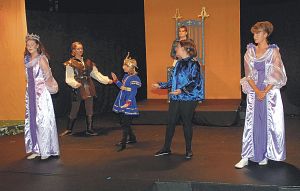

Members of the cast of "The Firebird" go through final rehersals. The production, staged at the Jonesborough Repertory Theatre, is really two plays at once ? one for the hearing and one for the deaf. (Photo by David Crigger|Bristol Herald Courier).
*** This story was published Oct. 12, 2008 in the Bristol Herald Courier. ***
JONESBOROUGH, Tenn. ? You cannot clap and get your point across. The deaf, after all, cannot hear you banging your hands together. So instead, you must flail your hands above your head ? and wiggle them wildly. And then come the smiles, along with the clapping, at the conclusion of the Jonesborough Repertory Theatre's production of The Firebird. [Performances were held Oct. 9-12.]
This is kind of like a split screen ? or a split stage, you should say ? with two plays going on at once: one for the hearing and one for the deaf. And yet, it's really only one. It feels like only one in that the actors all mesh together ? the ones who can hear and the three who have no hearing. Like duplicates, these performers gracefully glide across the small stage in a practice called "Shadow Acting" or "Shadow Interpreting."
"Each role on stage has an acting interpreter and a voicing actor," said Kathleen Buttolph, the artistic director of the Jonesborough Repertory Theatre. "So, there are two people that develop each character."
LOYALTY
Dating back centuries, The Firebird is a coming-of-age classic by Evan Guilford-Blake. It's about handing a king a feather and going to the land of Never. Talking to a lobster to find a wedding dress. Listening to your horse and finding your life is a mess.
"There are many versions of The Firebird," show director Janette Gaines said. "This version centers around the importance of communication, friendship and loyalty."
You'll also find a story of reaching out. The split-stage nature of this show becomes part of the concept. Or as the director, Gaines, put it, "Loyalty and honest overcome communication barriers."
GOES TO TWO
Ten-year-old Colin Jeffress plays a pint-sized king ? and simply steals the show. At times, it's hard for this boy to deliver his laughable lines ? without laughing ? as he orders the Duke to have a princess brought to him.
Fifteen-year-old Pollie Griffin plays the Duke who can talk, while 22-year-old Ashley Reuss portrays the Duke who uses sign language. "And it's actually a lot of fun," Griffin said, "because we get to work off of each other."
Besides putting up with their wisecracking horses, these Dukes encounter a lobster, who of all things, holds the key to the princess's wedding dress.
In this production, the role of the talking crustacean goes to Sharon Squibb, an art teacher at the University School of East Tennessee State University in Johnson City. Squibb's interpretation of this dancing lobster crawls with enough over-the-top qualities that Squibb could be at home on the screen of Spongebob SquarePants.
And just who is the princess? Well, that role, like all others, goes to two. M.J. Light, a sign language interpreter from Bluff City, plays the "Signing Princess." "I've always interpreted roles trying to be in the background," Light said. "But it's hard actually acting at the same time."
REALLY FASCINATED
Kathleen King, a 14-year-old student at Johnson City's Science Hill High School, plays the princess who talks.
Why did King volunteer for this play? "I was really fascinated by the deaf actors," King said. "I had never seen deaf actors before."
Reuss, a 24-year-old from Johnson City, is among the play's actors who cannot hear. She lost her hearing from a serious ear infection at age 2. "I just came originally just to help out with the play, but it really looked like fun," Reuss said through an interpreter. "And they asked me if I wanted to be involved as a signing actor. And I jumped at the chance."
THE ACTORS
For Gaines, the director, this show becomes personal. Her 17-year-old twin daughters are hearing impaired; both wear hearing aids. "But their main means of communication is spoken English," Gaines said.
In many ways, Gaines finds that this production ? offering the deaf a performance with sign language ? is a healing thing.
"As a parent of hard-of-hearing daughters, I have witnessed the ping-pong effect of watching a play interpreted in the standard 'on the floor' method," Gaines said. "For my daughters and for all other deaf theater lovers, I would like to offer a play they can enjoy to its fullest along with the hearing actors."
READ ON: